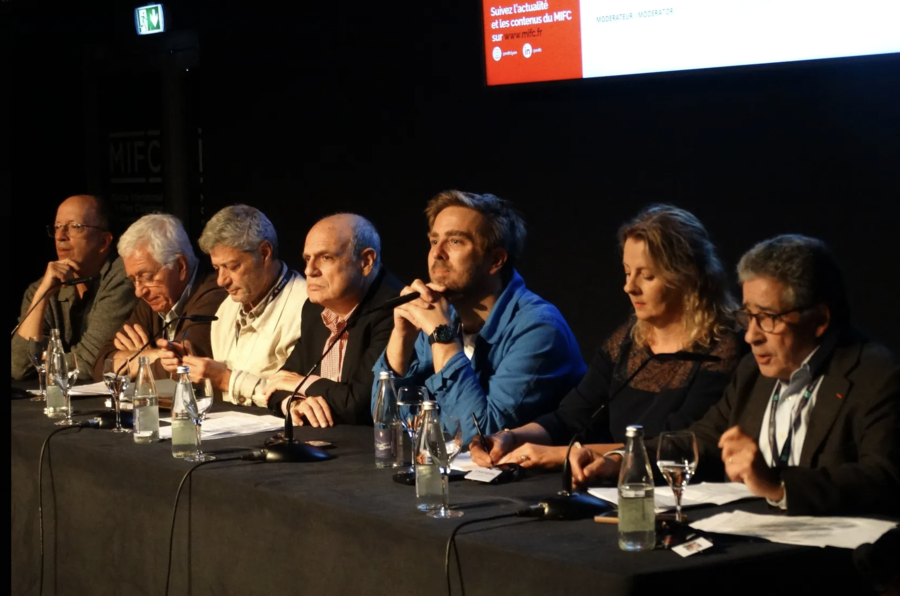Towards an audiovisual heritage policy?
A real sore point in heritage policy, audiovisual heritage was at the heart of discussions on Wednesday, October 15, 2025, when the International Classic Film Market brought together several key players in the field for a round table moderated by Damien Choppin, journalist for Satellifacts, starting with Michel Gomez, author of a 194-page report on the preservation and promotion of audiovisual heritage published on the sidelines of the round table. Alongside Antoine Bayet (INA), Jacques Fansten (SACD), Laurent Jaoui (U2R), Sabrina Joutard (SCFP), André Labbouz (CST), and Jean-Yves Mirski (FICAM), the economist and former general delegate of the City of Paris's Mission Cinéma presented his scathing conclusions on the subject, recommending the implementation of a genuine audiovisual heritage policy.

1/ Details of Michel Gomez's report
Michel Gomez's mission focused on stock audiovisual works that are 20 years old or older, he explained to the Market audience when presenting his conclusions, highlighting four key findings:
- Extreme confusion, a lack of data, and a changing environment: there is no database that clearly references audiovisual works, nor are there any reports on the subject, and the INA has not been responsible for the property rights of audiovisual works since 1981, which confuses professionals, but there are many changes and developments in the sector (e.g., the creation of madelen by the INA).
- A very narrow and poorly regulated market: thanks to data from the SACD, we discover that 78% of works produced before 2003 are no longer broadcast after 2010 and that the agreement on the exploitation of works signed in 2016 has not been applied.
- An audiovisual market that is not conducive to the broadcasting of heritage works: broadcasters are reluctant to broadcast heritage works and distributors have extensive catalogs that are rarely or never exploited. There are also technical and legal obstacles (particularly with regard to orphan works and company liquidations) to the broadcasting of audiovisual heritage.
- A lack of identification of an audiovisual heritage policy at the CNC: responsibility for heritage policy falls on rights holders and producers.
His recommendation is simple: implement a policy that clearly takes the market into account without being exhaustive and in association with the industry.
- Need to institutionalize this future heritage policy: the CNC must take ownership of this heritage policy, institutional roles must be clarified, CST-RT-043 must be redesigned to include audiovisual heritage, and procedures must be renewed.
- Ensuring the preservation of heritage must be a major priority: data must be available on the availability of works, and a plan must be put in place to protect works from 1980-2005.
- Dissemination must be encouraged by creating a heritage corner on audiovisual platforms and improving the obligations of the SMAD decree.
After Michel Gomez presented his report and conclusions, the other participants in the round table discussion took the floor and raised several points.
2/ Audiovisual heritage is virtually unknown
- Defining audiovisual heritage: not all audiovisual creations are equal. Artistic television, long-running series, one-off dramas, and TV movies are not treated in the same way. We need to establish a common, popular audiovisual heritage.
- Lack of promotion: older works were not promoted at the time of their creation due to the economic system of the era, and they were often only broadcast once.
- The need for referencing: without concrete data to identify its heritage, the audiovisual sector struggles to promote itself. Catalogs must be made available, which is what U2R is doing, and an inventory of works must be initiated to see what exists, whether there are negatives, and whether their restoration is possible. To achieve this, public and private entities must collaborate, particularly on the issue of rights holders, which will resolve the difficulties surrounding orphan works.
3/ The problem of preserving audiovisual heritage
- The urgency for service providers: storage has evolved and costs have increased, with service providers storing works without knowing what to do with them. The burden of orphan works or works in limbo also falls on service providers.
- Digital works from 1980 to 2005: we have no perspective on their preservation and do not know how to use them.
4/ Redefining an institutional and legal framework
- The limitations of CST-RT-043: a fundamental text for classic cinema without an audiovisual component, it needs to be improved.
- Rethinking the 2016 agreement: the agreement on the exploitation of works is effective for classic cinema, and as it will celebrate its tenth anniversary in 2026, it should be extended to audiovisual heritage.
5/ What are the options?
- The example of INA madelen: launched in 2020, the SVOD platform proves that the audiovisual heritage is of interest to the public and broadcasters. The INA presents content for which it owns the rights, but that's not all: acquisition mandates have also increased its offering to 10,000 works, some of which have been restored. The editorial work is a major part of the platform, alongside broadcasting, and it is bearing fruit. However, TV movies and one-off dramas are not clearly accessible on the platform.
- Take inspiration from what is being done in the film industry, particularly within the SCFP. However, there must be clear separation between film and audiovisual budgets, as the economic models are different and are becoming increasingly rigid.




